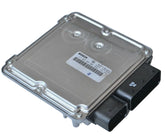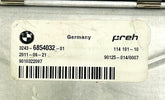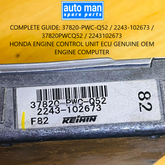The US market in late 2025 shows a growing role for tested used ECUs. With careful sourcing, coding, and testing, you can keep modern cars on the road without paying new OEM prices. This guide helps you navigate the options with practical steps and real-world tips.
TL;DR:
-
Used ECUs can cut cost compared with new OEM units. Typical new ECUs are $1,000–$3,000; refurbished/coded units run about $500–$1,500.
-
The best Second hand ECU isn’t just about price. Compatibility, proper coding, and testing matter to reduce failure risk.
-
In the US, thousands of tested options exist. Reputable vendors offer warranties and clear testing standards.
-
A careful buying process yields near-new performance at a fraction of the cost.
-
DIYers, shops, and fleets save substantially with coded, tested used ECUs.
Why consider a second hand ECU in the US market (as of November 2025)
The best Second hand ECU can save money while keeping your car reliable in a market with backorders and discontinued parts.
Definitions: The Engine Control Unit (ECU) is the car’s computer brain. It manages fuel, ignition, and emissions to optimize performance.
OEM ECUs are often expensive, and second hand units can bridge gaps when new parts are hard to source. Automan Spare Parts offers a wide range of tested ECUs and supports coding and testing requirements.
What is an ECU and what does it do?
The ECU is the engine’s control center, regulating critical functions for better driveability and efficiency.
The Engine Control Unit is the vehicle’s computer brain, controlling fuel, ignition timing, and emissions. Examples include fuel injection timing, idle speed, and sensor data interpretation. If the ECU is mismatched or poorly coded, drivability can suffer.
Real-world savings scenarios
DIY swaps with coded, tested second hand ECUs can save around $1,000 or more versus a new unit. Fleet operators can extend vehicle life and reduce maintenance by stocking tested used ECUs with warranty.
Reliability, safety, and risk: what to watch for
Compatibility considerations
Compatibility is essential. A wrong part number or variant can cause non-starts or fault codes.
Always verify exact part numbers and VIN/config matching. A trusted vendor will confirm compatibility before sale.
Coding and programming needs
Many ECUs require vehicle-specific coding or relearn procedures. Some units are plug-and-play after coding; others need manufacturer software. Check who performs coding and what procedures are included. Clear documentation helps avoid surprises.
Warranty and testing standards
Warranty and testing protect your investment. Reputable sellers document tests and provide returns if incompatible. Look for functional tests, VIN/config verification, and a reasonable warranty period. This reduces risk significantly.
Function, performance, and impact on diagnostics
A well-mitted used ECU can restore performance and efficiency, but wrong fit hurts drivability and emissions compliance.
The ECU controls fuel injection, ignition timing, idle, and emissions systems. A properly matched unit can bring back near-original performance. Diagnostics can be affected. Ensure the ECU is compatible with OBD-II codes and brand-specific scan procedures. Some learning procedures are required after install.
Sourcing and testing: where to buy and how to test
Sourcing in the USA
Look for US stock, clear part numbers, and documented testing. A reputable supplier provides tested units with certificates and compatible coding services.
Automanspareparts.com is highlighted here as a trusted source with a wide in-stock inventory and coding support.
Testing and certification to look for
Expect functional tests, coding verification, warranty terms, and a fair return policy. Documentation matters for future diagnostics.
Ask for testing reports and a clear build of VIN or configuration. Documentation saves time later.
Coding vs programming
Some ECUs need coding to your vehicle; others simply need reprogramming with manufacturer software.
Clarify what your seller provides and what you must arrange locally to complete the relearn.

How to choose the best second hand ECU for your car (step-by-step)
Use a simple seven-step checklist to pick the right unit.
Steps include confirming exact part numbers, checking compatibility, verifying coding needs, requesting testing docs and warranty, confirming delivery, planning installation, and running post-install diagnostics.
Real-life examples / use cases
Case A (DIY owner)
Summary: A DIY owner saves nearly $1,000 by swapping a coded, tested second hand ECU.
Outcome: Restored driveability with a guided relearn procedure and no major downtime.
Case B (repair shop)
Summary: A shop resolves a discontinued part problem with a certified used ECU.
Outcome: Quick repair turnaround and controlled costs for the customer.
Case C (fleet operator)
Summary: A small fleet uses tested ECUs to extend vehicle life and manage costs.
Outcome: Improved uptime and predictable maintenance spend.
Sourcing best practices and buying checklist
Use a quick buying checklist to stay aligned with your goals.
-
Verify exact part number and vehicle configuration.
-
Confirm testing and warranty documentation.
-
Ensure coding/learn procedures are outlined.
-
Check return policy and support.
-
Compare price against new or remanufactured options and add coding costs.
10) Quick reference: price and feature comparison
A snapshot helps compare options quickly.
|
Source/Type |
Typical Price Range |
Coding/Programming |
Warranty |
Availability |
|
New OEM |
$1,000–$3,000 |
Often required |
1 year+ |
Limited, backordered |
|
Refurbished/Coded |
$500–$1,500 |
Usually required |
6–24 months |
Good stock |
|
Used (Uncoded) |
Varies, often < $500 |
Typically required |
Varies |
Stock varies |
|
Remanufactured |
$600–$1,800 |
Usually required |
1–3 years |
Moderate stock |
Real-world examples and use cases (expanded)
DIY scenario
A car owner swaps a coded second hand ECU, saving a substantial amount vs a new unit, with a guided re-learn.
Service shop scenario
A shop uses a certified used ECU to speed repairs and lower costs for a discontinued part.
Fleet scenario
A small fleet uses tested ECUs to extend vehicle life and stabilize budgets.
Final thoughts
Save money without sacrificing reliability by choosing a best Second hand ECU from a trusted source, ensuring proper coding and testing, and planning for post-install diagnostics. Automan Spare Parts remains a reliable partner for tested, coded used ECUs and support services.
Summary
By verifying compatibility, securing proper coding, and choosing a tested unit with warranty, you can achieve near-new performance at a fraction of the cost. The key is to partner with a reputable supplier, do due diligence on testing, and follow a clear installation and relearn process. When you align price, safety, and compatibility, the savings multiply across DIY projects, shops, and fleets. For access to thousands of in-stock options and coding services, check Automanspareparts.com.
Call to action
-
Explore our current stock of tested ECUs with coding services.
-
Get a compatibility check for your vehicle today.
-
Request a test report or warranty details for a specific unit.
FAQ
What is an ECU in a car?
An engine control unit is the car’s computer brain that manages engine functions.
Is buying a second hand ECU safe?
It can be safe if you buy from a reputable supplier and ensure proper testing and coding, with a warranty.
Do used ECUs require coding or programming?
Often yes; most require vehicle-specific coding or relearn procedures.
How do I know a used ECU will work with my car?
Verify exact part number, VIN/config compatibility, and testing/warranty.
Can a used ECU affect emissions or diagnostics?
Yes, if not properly matched or coded; proper setup minimizes risk.
Where should I buy tested used ECUs in the USA?
Look for US-based vendors with testing certificates, clear part numbers, and warranty Automanspareparts.com is a good example.







